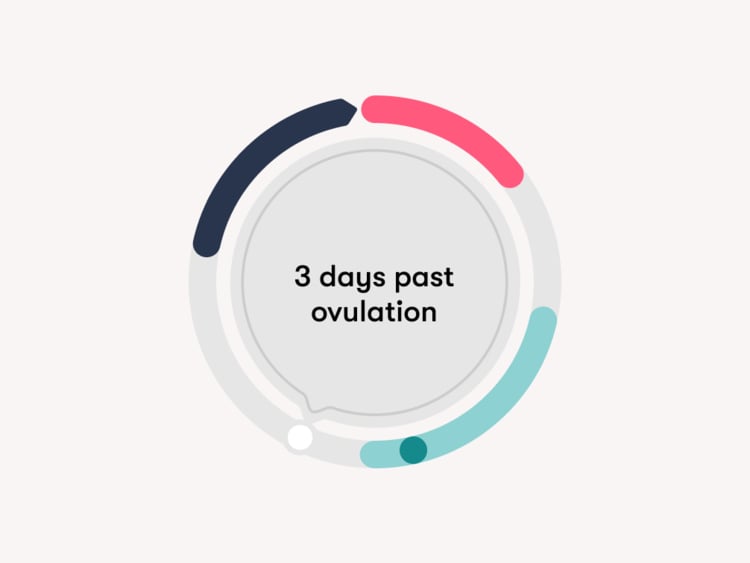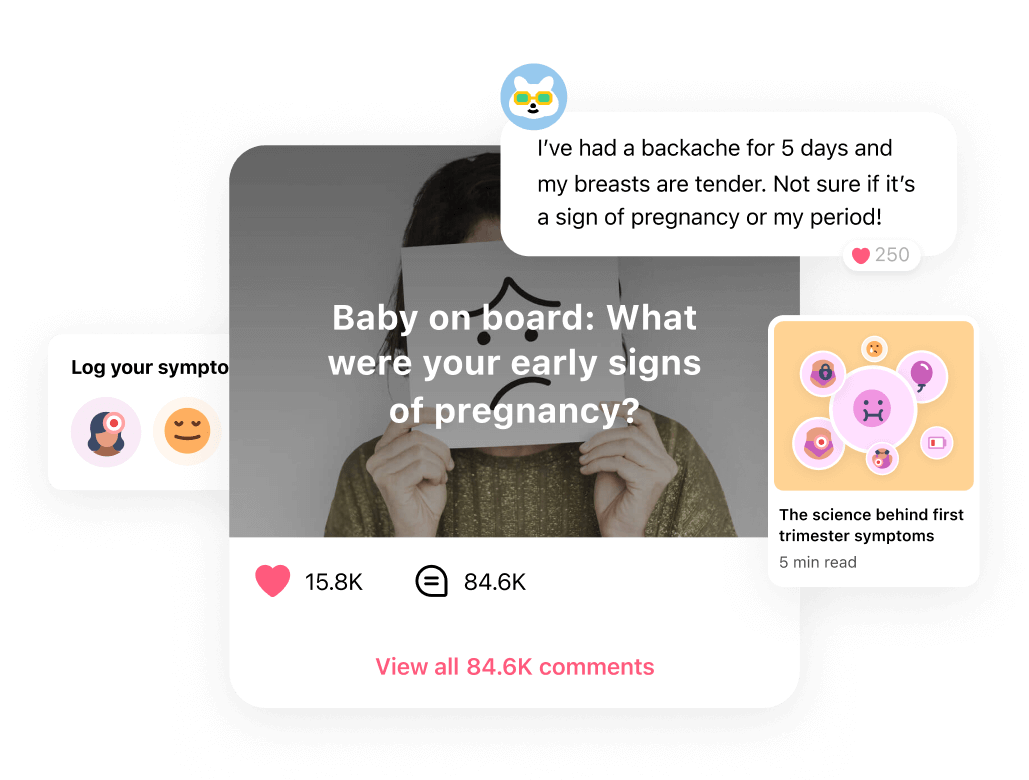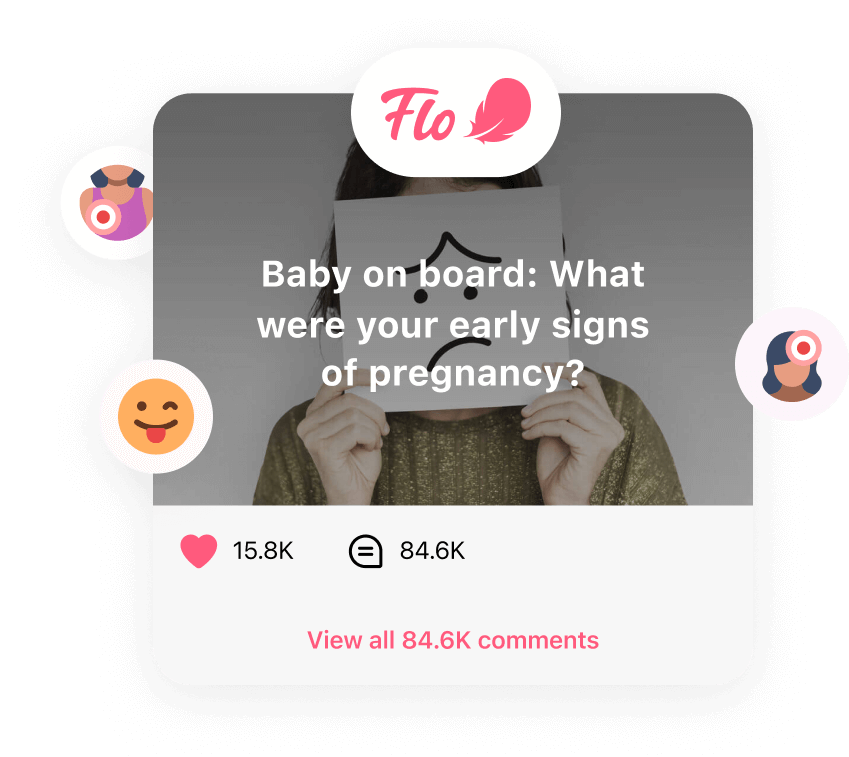Are you wondering when you can take a pregnancy test? Here’s the lowdown on 3 DPO.
-
Tracking cycle
-
Getting pregnant
-
Pregnancy
-
Help Center
-
Flo for Partners
-
Anonymous Mode
-
Flo app reviews
-
Flo Premium New
-
Secret Chats New
-
Symptom Checker New
-
Your cycle
-
Health 360°
-
Getting pregnant
-
Pregnancy
-
Being a mom
-
LGBTQ+
-
Quizzes
-
Ovulation calculator
-
hCG calculator
-
Pregnancy test calculator
-
Menstrual cycle calculator
-
Period calculator
-
Implantation calculator
-
Pregnancy weeks to months calculator
-
Pregnancy due date calculator
-
IVF and FET due date calculator
-
Due date calculator by ultrasound
-
Medical Affairs
-
Science & Research
-
Pass It On Project New
-
Privacy Portal
-
Press Center
-
Flo Accuracy
-
Careers
-
Contact Us
3 DPO: Are there any pregnancy symptoms at 3 days past ovulation?


Every piece of content at Flo Health adheres to the highest editorial standards for language, style, and medical accuracy. To learn what we do to deliver the best health and lifestyle insights to you, check out our content review principles.
When you’re trying for a baby, waiting for the right time to take a pregnancy test can feel like an eternity. If you’ve been trying to conceive, it’s normal to be hyper-aware of subtle bodily changes and wonder if every little twinge is a potential symptom. From a missed period to sore breasts and nausea, common signs of early pregnancy can look different for everyone. But is it possible to experience pregnancy symptoms as early as 3 DPO?
DPO — or days past ovulation — is the number of days since you ovulated. So, if you’re 3 DPO, one of your ovaries released an egg roughly three days ago. While some people report symptoms within a week of conception, 3 DPO is generally too early to tell if you are pregnant, because you aren’t — yet.
Here’s the thing: If a sperm fertilizes your egg during your fertile window, then you’ve conceived. But you’re not officially pregnant until implantation (the embryo attaching to the lining of your uterus) happens, typically around six to 10 days after ovulation. So, it is possible that you could still get pregnant during this cycle — it just hasn’t happened yet. Confused? We’ll break it down for you.
Key takeaways
- 3 DPO is generally too early for pregnancy symptoms to be detected because implantation hasn’t happened yet. This doesn’t necessarily mean you won’t get pregnant though.
- Early pregnancy and your monthly menstrual cycle can share pretty similar symptoms, so it can be hard to determine if you’re pregnant from signs and symptoms alone.
- Pregnancy symptoms don’t usually start until after implantation, which can be as early as six DPO.

 Over
7.8M
ratings averaging
4.8/5
*
Over
7.8M
ratings averaging
4.8/5
*
Understand your body’s signals with the Flo app
- Chat with others who are trying to get pregnant.
- Get trusted information on signs of pregnancy from 100+ medical experts.
- Log your symptoms and learn what they could be trying to tell you.
 Over
7.8M
ratings averaging
4.8/5
*
Over
7.8M
ratings averaging
4.8/5
*

Trying to conceive?
The Flo app can help you through the two-week wait.

 Over
7.8M
ratings averaging
4.8/5
*
Over
7.8M
ratings averaging
4.8/5
*
Understand your body’s signals with the Flo app
- Chat with others who are trying to get pregnant.
- Get trusted information on signs of pregnancy from 100+ medical experts.
- Log your symptoms and learn what they could be trying to tell you.
3 DPO: What is happening to your body?
At 3 DPO, you’re in the luteal phase of your cycle. If you’re reading this and thinking “what is a luteal phase?” then don’t worry. Prepare for a quick biology lesson.
Your cycle can be split into two stages, divided by your period and ovulation.
- The follicular phase: Depending on the length of your cycle, your follicular phase usually happens during the first 14 days of your cycle, and a new menstrual cycle starts on the first day of your period. During this time, your estrogen levels rise, and the lining of your uterus thickens in preparation for a potential pregnancy.
- The luteal phase: If you have a cycle that lasts 28 days, typically, around day 14, one of your ovaries will release an egg. This is ovulation and marks the start of your luteal phase. If you’re trying for a baby, then you can use an app like Flo or an ovulation calculator to figure out when you might have last ovulated.
“The luteal phase is the stage of the menstrual cycle from ovulation to your next period,” says Dr. Sara Twogood, obstetrician and gynecologist, Cedars-Sinai Medical Group, California, US. During this time, your progesterone levels rise to support a potential pregnancy. If your egg was fertilized by a sperm, then you can become pregnant.
After your ovaries release an egg, there is a 12-to-24-hour period where it can be fertilized by a sperm as it makes its way down your uterine tube. Once you’ve ovulated, it can take six to 10 days for an egg to implant into the lining of your uterus, otherwise known as six to 10 DPO.
After implantation has occurred, your body will release human chorionic gonadotropin (hCG) — the pregnancy hormone that pregnancy tests look for in your urine for a positive result. But it can still take a few more days for hCG levels to rise high enough to show up on a test, which is why it’s best to wait until the first day of a missed period before you take a pregnancy test.
You might have heard of the luteal phase being described as the “two-week wait” because when you’re trying to conceive, that tricky time between ovulation and when your period usually starts is essentially a waiting game. And while it’s usually only two weeks, if you’re wanting to get pregnant, it can feel like an eternity.
That said, understanding the signs and symptoms of early pregnancy and knowing what happens during this stage of your menstrual cycle can help you feel more prepared and in tune with your body, so let’s find out more.
Can I take a pregnancy test at 3 DPO, or is it too early?
Whether you’re trying to get pregnant or not, thinking you’re pregnant but not being entirely sure can be stressful. Three DPO is generally too early to take a pregnancy test. This is because the tests work by detecting the pregnancy hormone hCG. Your body produces much more hCG following implantation, usually between six and 10 DPO.
Generally speaking, your hCG levels multiply quickly in your first few weeks of pregnancy. But if you test too soon, you could get a false-negative test result. While it might feel like an impossible wait — for an accurate result — the best time to take a pregnancy test is the first day of your missed period.
3 DPO symptoms
Feeling nauseous, bloated, or tired? When you’re trying to conceive, it’s tempting to look for pregnancy clues. But thanks to fluctuating hormones, many of the symptoms associated with early pregnancy can also be linked to premenstrual symptoms.
Three DPO is too early to take a test because implantation hasn’t happened yet. Your body won’t yet be producing enough hCG to be picked up on a pregnancy test. So, you can’t get a definite answer as to whether you’re expecting just yet. However, you may notice some symptoms in the run-up to your period starting. These could be signs of premenstrual syndrome (PMS). Tracking them may help you spot a change and signs of early pregnancy.
Symptoms you might start to notice at 3 DPO include:
Fatigue
Can’t keep your eyes open? This may all be due to progesterone, which helps to thicken the lining of your uterus before implantation and supports your pregnancy once you’ve conceived. It may also make you feel wiped out by the end of the day.
Your hormones fluctuate during your luteal phase, whether you’ve conceived or not, and fatigue is a common early sign of pregnancy. It could also be linked to premenstrual symptoms. So, annoyingly, at 3 DPO, reaching for a blanket at 7 p.m. isn’t a surefire sign of pregnancy.
Bloating
Thanks to a boost in progesterone and estrogen during your luteal phase, it’s fairly typical to feel bloated after ovulation. However, bloating is also a common early pregnancy symptom, so again, it’s a case of having to wait until you see two lines on a pregnancy test before jumping to conclusions.

Backache and cramping
Cramping can happen before your period or around implantation. You might know the feeling of reaching for a hot water bottle to soothe aches all too well.
Cramps are caused by changes in your hormone levels and hormone-like substances called prostaglandins. Prostaglandins play some pretty crucial roles in the body, aiding in ovulation, your period, and blood clotting.
Back pain and cramping are also both common pregnancy symptoms and may be triggered after implantation at six to 10 DPO. However, since it can indicate implantation or be a sign that your period is coming, it’s still too early to count cramping as a sign of pregnancy.
Nausea
Nausea caused by a spike in pregnancy hormones is a telltale sign that a baby is on the way. But, you guessed it, it’s common to feel queasy at different points in your cycle too.
Breast sensitivity
Your boobs can change a lot during pregnancy. Changes in your hormones can mean that they grow, change shape, and become more sensitive as they prepare for milk production. It’s pretty typical for them to feel heavy, tender, or swollen after you’ve conceived. However, hormone changes before, during, and after your period can also lead to breast pain and sensitivity.
Take a quiz
Find out what you can do with our Health Assistant
3 DPO and no symptoms
If you’re trying for a baby and you don’t feel anything at all at 3 DPO, try not to worry. Please remember that your fertilized egg may not have even implanted at this stage, so it’s very normal not to feel anything. And if you do become pregnant, annoyingly, there isn’t a fixed timeline for when you’ll feel it. Everyone experiences pregnancy differently. Aside from missing your period, you might not have any symptoms for several weeks.
Trying to conceive can be an emotional time, so try to be kind to yourself. Doing little things to take your mind off of it over the two-week wait can help. Starting a new book or TV series, committing to a daily exercise or mindfulness practice, or simply calling a friend each time your mind wanders to it can all help.
More FAQs
Why am I so emotional 3 days after ovulation?
Changes in your hormone levels trigger the thickening of the lining of your uterus before ovulation, but they also play a part in regulating your mood. In the days after you ovulate, your hormone levels change, which might leave you feeling a little bit sad or more annoyed than usual. For many, this is only temporary, and your mood will improve as your estrogen levels rise again later in your luteal phase.
What does discharge look like after ovulation if pregnant?
Getting familiar with your discharge (and how it changes) can tell you a lot about where you are in your cycle. After ovulation, before you get your period, your cervical mucus is usually drier. However, if you notice an increase in discharge that is thin and a clear or milky white color, it may be a sign that you’ve conceived. Just remember that every pregnancy is different, so if you don’t notice any changes, it doesn’t necessarily mean you’re not pregnant.
Do you become dry after ovulation?
The short answer is yes. You might notice changes to your vaginal discharge during your cycle. And this is all related to, you guessed it, your hormones. After ovulation, your estrogen levels drop temporarily, and your progesterone levels rise. This can lead to your discharge feeling thicker or dry and less slippery.
Why is my stomach cramping 3 days after ovulation?
In the days after you ovulate, you might notice some cramping. This is known as ovulation pain. It’s caused by your ovary releasing an egg and can last anywhere from a few minutes to 48 hours. 3 DPO is quite late to be feeling ovulation pain, so if you’re feeling cramping around this time, it could be a sign that your period is coming. It may be a symptom of PMS or could be something else. If the pain gets worse or lasts longer, you should reach out to your doctor.


Hey, I'm Anique
I started using Flo app to track my period and ovulation because we wanted to have a baby.


The Flo app helped me learn about my body and spot ovulation signs during our conception journey.


I vividly
remember the day
that we switched
Flo into
Pregnancy Mode — it was
such a special
moment.
Real stories, real results
Learn how the Flo app became an amazing cheerleader for us on our conception journey.
References
“Am I Pregnant?” Cleveland Clinic, my.clevelandclinic.org/health/articles/9709-pregnancy-am-i-pregnant. Accessed 16 Nov. 2023.
Betz, Danielle, and Kathleen Fane. “Human Chorionic Gonadotropin.” StatPearls. StatPearls Publishing, 2023, www.ncbi.nlm.nih.gov/books/NBK532950/.
“Cervical Mucus.” Cleveland Clinic, my.clevelandclinic.org/health/body/21957-cervical-mucus. Accessed 16 Nov. 2023
“Changes during Pregnancy.” The American College of Obstetricians and Gynecologists, www.acog.org/womens-health/infographics/changes-during-pregnancy. Accessed 16 Nov. 2023.
Charlewood, G. P. “Mittelschmerz or Ovulation Pain.” Suid-Afrikaanse Tydskrif vir Geneeskunde [South African Medical Journal], vol. 32, no. 10, Mar. 1958, pp. 261–62.
“Conception: How It Works.” UCSF Health, www.ucsfhealth.org/education/conception-how-it-works. Accessed 17 Nov. 2023.
Dean, Erin. “Morning Sickness.” Nursing Standard, vol. 30, no. 50, 10 Aug. 2016, p. 15, https://doi.org/10.7748/ns.30.50.15.s16.
“Doing a Pregnancy Test.” NHS, www.nhs.uk/pregnancy/trying-for-a-baby/doing-a-pregnancy-test/. Accessed 17 Nov. 2023.
“First Trimester Fatigue.” Johns Hopkins Medicine, www.hopkinsmedicine.org/health/conditions-and-diseases/first-trimester-fatigue. Accessed 17 Nov. 2023.
Gudipally, Pratyusha R., and Gyanendra K. Sharma. “Premenstrual Syndrome.” StatPearls. StatPearls Publishing, 2023, www.ncbi.nlm.nih.gov/books/NBK560698/.
“How Can I Tell When I’m Ovulating?” NHS, www.nhs.uk/common-health-questions/sexual-health/how-can-i-tell-when-i-am-ovulating/. Accessed 17 Nov. 2023.
“Luteal Phase.” Cleveland Clinic, my.clevelandclinic.org/health/articles/24417-luteal-phase. Accessed 16 Nov. 2023.
“Menstrual Cramps.” Mayo Clinic, 30 Apr. 2022, www.mayoclinic.org/diseases-conditions/menstrual-cramps/symptoms-causes/syc-20374938.
Nwabuobi, Chinedu, et al. “HCG: Biological Functions and Clinical Applications.” International Journal of Molecular Sciences, vol. 18, no. 10, Sep. 2017, https://doi.org/10.3390/ijms18102037.
“Ovulation Signs: When Is Conception Most Likely?” Mayo Clinic, 7 Dec. 2022, www.mayoclinic.org/healthy-lifestyle/getting-pregnant/expert-answers/ovulation-signs/faq-20058000.
“Premenstrual Syndrome (PMS).” Mayo Clinic, 25 Feb. 2022, www.mayoclinic.org/diseases-conditions/premenstrual-syndrome/symptoms-causes/syc-20376780.
“Progesterone.” Reactions Weekly, vol. 1508, no. 1, July 2014, p. 32.
“Prostaglandins.” Cleveland Clinic, my.clevelandclinic.org/health/articles/24411-prostaglandins. Accessed 16 Nov. 2023.
“Signs and Symptoms of Pregnancy.” NHS, www.nhs.uk/pregnancy/trying-for-a-baby/signs-and-symptoms-of-pregnancy/. Accessed 17 Nov. 2023.
“Stomach Pain in Pregnancy.” NHS, www.nhs.uk/pregnancy/related-conditions/common-symptoms/stomach-pain/. Accessed 17 Nov. 2023.
Su, Ren-Wei, and Asgerally T. Fazleabas. “Implantation and Establishment of Pregnancy in Human and Nonhuman Primates.” Advances in Anatomy, Embryology, and Cell Biology, vol. 216, 2015, pp. 189–213, https://doi.org/10.1007%2F978-3-319-15856-3_10.
Thiyagarajan, Dhanalakshmi K., et al. “Physiology, Menstrual Cycle.” StatPearls. StatPearls Publishing, 2022, www.ncbi.nlm.nih.gov/books/NBK500020/.
“Vaginal Discharge in Pregnancy.” NHS, www.nhs.uk/pregnancy/related-conditions/common-symptoms/vaginal-discharge/. Accessed 17 Nov. 2023.
“Week 4.” Start for Life, www.nhs.uk/start-for-life/pregnancy/week-by-week-guide-to-pregnancy/1st-trimester/week-4/. Accessed 16 Nov. 2023.
“Week 10.” Start for Life, www.nhs.uk/start-for-life/pregnancy/week-by-week-guide-to-pregnancy/1st-trimester/week-10/. Accessed 16 Nov. 2023.
“You and Your Pregnancy at 1 to 3 Weeks.” NHS, www.nhs.uk/pregnancy/week-by-week/1-to-12/1-2-3-weeks/. Accessed 17 Nov. 2023.
History of updates
Current version (24 November 2023)
Published (17 June 2019)
In this article

Get your personal guide to fertility
-
Learn how to read your body's ovulation signals
-
Find daily conception tips from our experts
-
Chat with others who are trying to get pregnant




